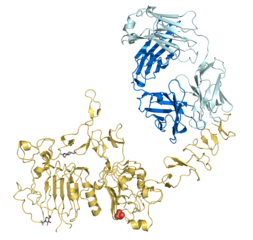All AbMole products are for research use only, cannot be used for human consumption.

In vitro: Trastuzumab has been demonstrated to exert a variety of anti-tumor effects selectively in HER2-overexpressing tumor cells. Trastuzumab binds to the juxtamembrane domain of HER2 and upon receptor binding, the antibody downregulates the expression of HER2. Trastuzumab selectively blocks ligand-independent HER2-HER3 dimerization. In addition, trastuzumab binding to HER2 blocks proteolytic cleavage of the extracellular domain of HER2, resulting in diminished levels of the more active p95-HER2 form of HER2. As a result of these effects on the HER2 receptor, trastuzumab causes downregulation of PI3K pathway signaling and downstream mediators of cell cycle progression such as cyclin D1. Trastuzumab not only inhibits HER2 signaling pathways but also triggers immune-mediated responses against HER2-overexpressing cells. Trastuzumab binding engages Fc receptors on immune effector cells leading to antibody-dependent cellular cytotoxicity. Beyond these effects, trastuzumab has been shown to have antiangiogenic effects and to lower the proapoptotic threshold for chemotherapy.
In vivo: Trastuzumab is shown to be safe when administered chronically to a range of animals including primates. In experiments mimicking adjuvant therapy of submacroscopic disease in vivo (JIMT-1 cells inoculated s.c. in severe combined immunodeficiency mice), trastuzumab is able to inhibit the outgrowth of macroscopically detectable xenograft tumors for up to 5-7 weeks. Trastuzumab has a remarkable antitumor effect and is currently used worldwide for the treatment of breast cancer. In in vivo models, trastuzumab decreases the microvessel density of breast cancer xenografts. It is well documented that trastuzumab acts directly in cancer cell signaling, as well as indirectly via the immune system.

Talanta. 2025 Apr 1;285:127431.
Biologically-driven RAFT polymerization-amplified platform for electrochemical detection of antibody drugs
Trastuzumab purchased from AbMole

Br J Cancer. 2024 Apr 10.
Neratinib could be effective as monotherapy or in combination with trastuzumab in HER2-low breast cancer cells and organoid models
Trastuzumab purchased from AbMole

Anal Chem. 2023 Sep 19;95(37):14094-14100.
Amplification-Free Ratiometric Electrochemical Aptasensor for Point-of-Care Detection of Therapeutic Monoclonal Antibodies
Trastuzumab purchased from AbMole

NPJ Breast Cancer. 2022 Jan;8(1):1.
Effects of neoadjuvant trastuzumab, pertuzumab and palbociclib on Ki67 in HER2 and ER-positive breast cancer
Trastuzumab purchased from AbMole
| Cell Experiment | |
|---|---|
| Cell lines | JIMT-1, SKBR-3, and BT-474 cells |
| Preparation method | Exponentially growing cells are harvested and plated in single wells of a 96-well flat-bottomed tissue culture plate at defined densities, ranging from 4,500–8,000 cells per well depending on the cell line. After overnight culture, the regular medium is exchanged to medium containing 0, 1, 10, or 100 μg/mL trastuzumab or trastuzumab-F(ab′)2. Cell viability is tested after 72 h of treatment. Fluorescence is detected at an excitation of 544 nm, and emission is detected at 590 nm. |
| Concentrations | 0, 1, 10, or 100 μg/mL |
| Incubation time | 72 h |
| Animal Experiment | |
|---|---|
| Animal models | SCID C.B-17 scid/scid and nu/nmri nude mouse |
| Formulation | saline |
| Dosages | 5 μg/g |
| Administration | i.p. |
| Molecular Weight | 145529.41 |
| Formula | C6470H10012N1726O2013S42 |
| CAS Number | 180288-69-1 |
| Storage | Store at -20°C or -70°C. Avoid multiple freeze-thaws. |
[4] Nahta R, et al. Oncogene. Trastuzumab: triumphs and tribulations.
| Related EGFR/HER2 Products |
|---|
| Depatuxizumab
Depatuxizumab is a brain-penetrant and humanized tumor-specific anti EGFR monoclonal antibody. Depatuxizumab inhibits the growth of xenograft models of mutant EGFRvIII and wild-type EGFR. |
| Sevabertinib
Sevabertinib is an epidermal growth factor receptor (EGFR) tyrosine kinase inhibitor with antitumor activity. |
| BPIQ-I
BPIQ-I (PD 159121) is a potent and ATP-competitive EGFR tyrosine kinase inhibitor.. |
| HKI-357
HKI-357 is an irreversible dual inhibitor of EGFR and ERBB2 with IC50s of 34 nM and 33 nM, respectively. |
| SJF-1528
SJF-1528 is a potent EGFR PROTAC degrader with DC50 values of 39.2 nM and 736.2 nM for wild-type EGFR in OVCAR8 cells and Exon 20 Ins mutated EGFR in HeLa cells. |
All AbMole products are for research use only, cannot be used for human consumption or veterinary use. We do not provide products or services to individuals. Please comply with the intended use and do not use AbMole products for any other purpose.


Products are for research use only. Not for human use. We do not sell to patients.
© Copyright 2010-2024 AbMole BioScience. All Rights Reserved.
